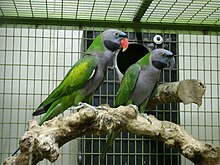Lord Derby's parakeet
| Lord Derby's parakeet | |
|---|---|

| |
| A pair - male on left and female on right | |
| Scientific classification | |
| Domain: | Eukaryota |
| Kingdom: | Animalia |
| Phylum: | Chordata |
| Class: | Aves |
| Order: | Psittaciformes |
| Family: | Psittaculidae |
| Genus: | Psittacula |
| Species: | P. derbiana
|
| Binomial name | |
| Psittacula derbiana | |
Lord Derby's parakeet (Psittacula derbiana), also known as Derbyan parakeet, is a parrot species,[3] which is confined to a small pocket of moist evergreen forest in the hills and mountains of the Indian states of Arunachal Pradesh and Assam, and adjoining parts of Tibet, Sichuan and Yunnan in China.[1] The species suffers from cutting of old trees (important for nesting sites) and poaching for the illegal wildlife trade.[1] In 2011, its status was updated from least concern to near threatened on the IUCN Red List.[1] The adult male and female are easily distinguished because they have different beak colours and slightly different plumage.[1]
The name of this bird commemorates Edward Stanley, 13th Earl of Derby.[citation needed]
Lord Derby's parakeets feed on fruits, berries, seeds, and leaf buds, occasionally foraging in gardens and fields.
Description

Lord Derby's parakeets are 45–50 cm (18–20 in) in length and are sexually dimorphic.[1] They have a mostly green plumage over their dorsal surface (i.e. from behind), black lores and lower cheeks, a bluish-purple crown and pale yellow eyes. The throat, breast, abdomen and under-wing coverts are greyish blue to lavender. The thighs and vent area are yellowish green with blue edging on some of the feathers. The tail feathers are shades of green, some edged with blue. Male birds have a red upper mandible with a yellow tip, while the lower mandible is black. The females have an all-black beak.
Immature Lord Derby's parakeets are duller in colour than the adults. Juvenile birds have green crowns, orange-red upper and lower mandible (beak), and their irises are dark and do not lighten until they reach maturity between two and three years of age.
Sexual dimorphism
- Adult male
-
The adult male has a red upper mandible
-
Male
-
Male pet kept in China
- Adult female
-
A female pet in Tibet. The adult female has an all black beak.
-
A female pet in China
-
A captive female in China
Reproduction


Breeding season usually begins between April and June. The female lays a clutch of two to four eggs (36.1 mm × 27.7 mm [1.42 in × 1.09 in]) in nest holes of trees. The young hatch after an incubation period of about 23 days and will fledge after 8 to 9 weeks.
Divergence
It was discovered that the divergence of Psittacula from other parrots occurred between 3.4 and 9.7 million years ago and divergence in Psittacula occurred between 2.5 and 7.7 million years ago. However, the divergence of derbyan parakeet occurred most recently between 0.2 and 0.5 million years ago.[4]
References
- ^ a b c d e f BirdLife International (2016). "Psittacula derbiana". IUCN Red List of Threatened Species. 2016: e.T22685500A93076177. doi:10.2305/IUCN.UK.2016-3.RLTS.T22685500A93076177.en. Retrieved 13 November 2021.
- ^ In Proceedings of the Zoological Society of London, 1850, p. 245 and plate Aves XXV, published on 24 Jan 1852 (see Philip Sclater, List of the Dates of Delivery of the Sheets of the 'Proceedings' of the Zoological Society of London, from the commencement in 1830 to 1859 inclusive in Proceedings of the Zoological Society of London, 1893, p. 239).
- ^ "Zoological Nomenclature Resource: Psittaciformes (Version 9.022)". zoonomen.net. 31 March 2009.
- ^ Groombridge, Jim J; Jones, Carl G; Nichols, Richard A; Carlton, Mark; Bruford, Michael W (1 April 2004). "Molecular phylogeny and morphological change in the Psittacula parakeets". Molecular Phylogenetics and Evolution. 31 (1): 96–108. doi:10.1016/j.ympev.2003.07.008. ISSN 1055-7903.
External links
- World Parrot Trust Parrot Encyclopedia - Species Profiles
- Lord Derby's parakeets in capital of Tibet
- Derbyan pictures and links
- BirdLife Species Factsheet
- Oriental Bird Images: Derbyan parakeet Selected photos
- http://animal-world.com/encyclo/birds/parakeets/DerbyanParakeet.php#
- http://home.wanadoo.nl/psittaculaworld/PsittaculaWorld.htm
- https://web.archive.org/web/20070606112952/http://www.ruffledfeathersaviary.com/derbyan_photos.htm
- Articles with short description
- Short description matches Wikidata
- Use dmy dates from October 2020
- IUCN Red List near threatened species
- Articles with 'species' microformats
- All articles with unsourced statements
- Articles with unsourced statements from June 2017
- Psittacula
- Birds of Northeast India
- Birds of Tibet
- Birds of Central China
- Birds of Yunnan
- Birds described in 1852
- Taxa named by Louis Fraser






